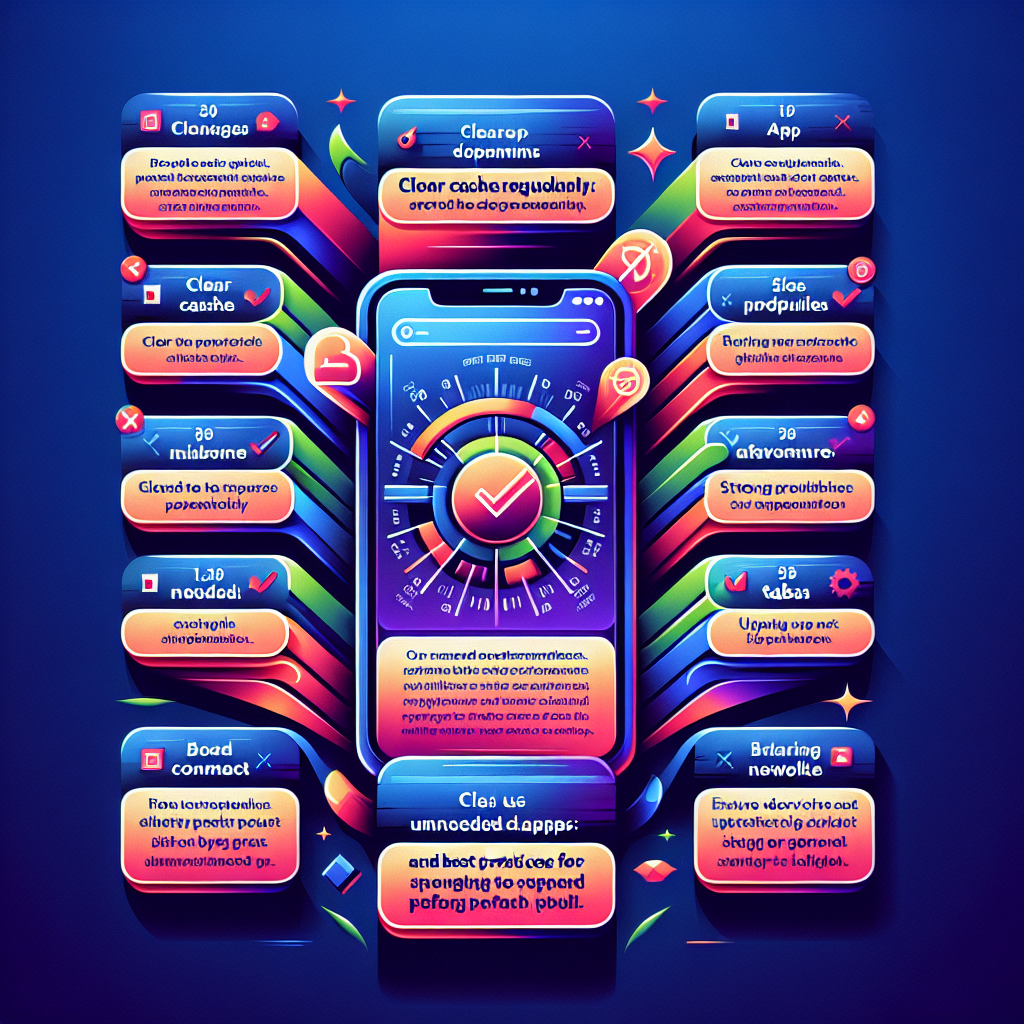In today’s fast-paced digital world, ensuring optimal internet performance on mobile devices is crucial for a seamless online experience. From faster loading times to uninterrupted streaming, implementing best practices is key to maximizing the efficiency of your mobile internet connection. This guide will explore a range of strategies and tips to optimize your mobile device’s internet performance, from clearing cache and cookies to utilizing data-saving options and optimizing network settings. By following these recommendations, you can enhance your browsing experience and make the most of your mobile device’s internet capabilities. Let’s dive into the world of improving internet performance on mobile devices!
Understanding Internet Performance on Mobile Devices
Mobile devices have become integral to our daily lives, serving as our primary gateway to the digital world. However, the internet performance on these devices can vary significantly due to several key factors that influence the user experience. To ensure optimal performance, it is crucial to understand the following:
- Factors affecting internet performance on mobile devices:
-
The performance of the internet on mobile devices is influenced by various factors, including network speed, device capabilities, and website design and content.
-
Network speed and stability:
-
The speed and stability of the network connection play a critical role in determining internet performance on mobile devices. Factors such as signal strength, network congestion, and bandwidth availability can impact the speed at which data is transmitted and received.
-
Device capabilities:
-
The hardware and software capabilities of the mobile device also play a significant role in internet performance. Factors such as processor speed, RAM capacity, and network compatibility can affect how quickly the device processes data and connects to the internet.
-
Website design and content:
- The design and content of websites accessed on mobile devices can impact internet performance. Websites that are not optimized for mobile viewing or contain large media files may take longer to load, leading to a slower browsing experience for users.
By understanding these factors that affect internet performance on mobile devices, users and developers can implement best practices to enhance the speed, reliability, and overall user experience while browsing the internet on their smartphones and tablets.
Optimizing Network Speed for Improved Performance
In the realm of mobile devices, optimizing network speed is paramount to ensuring a seamless and efficient online experience. Here are some key strategies to enhance internet performance on mobile devices by focusing on network speed:
Importance of a Strong Network Connection
- A strong network connection is the foundation for fast and reliable internet performance on mobile devices.
- Weak signals can lead to slow loading times, buffering during streaming, and interruptions during online activities.
- Prioritize connecting to networks with strong signals to maximize internet speed and stability.
Utilizing Wi-Fi Networks
- Wi-Fi networks generally offer faster and more stable connections compared to mobile data.
- When available, connect to trusted Wi-Fi networks to enjoy improved internet performance on mobile devices.
- Ensure the Wi-Fi network is secure to safeguard personal data and enhance overall online security.
Ensuring Good Signal Strength
- Check signal strength indicators on mobile devices to gauge the quality of the network connection.
- Position yourself closer to network sources such as routers or cellular towers to strengthen signal reception.
- Avoid areas with known signal interferences or obstructions to maintain consistent and strong network connectivity.
Using Mobile Data Effectively
- Monitor data usage to prevent exceeding data limits, which can lead to throttled speeds or additional charges.
- Consider utilizing data-saving features on mobile devices to optimize data consumption and improve internet performance.
- Switch between Wi-Fi and mobile data based on network availability and data usage requirements to maximize efficiency.
Enhancing Device Settings for Better Performance

To optimize internet performance on mobile devices, it is crucial to pay attention to the device settings. By making some adjustments and configurations, users can enhance their browsing experience significantly. Here are some key practices to consider:
-
Adjusting Network Settings: Users can improve internet speed by ensuring they are connected to a stable network. Switching to a faster Wi-Fi connection or enabling 4G/LTE data can boost browsing speeds.
-
Managing Data Usage: Limiting data-intensive activities and background data usage can prevent bandwidth congestion and improve internet performance. Users can set data limits, restrict background data access for specific apps, and monitor data usage regularly.
-
Optimizing Browser Settings: Tweaking browser settings can also contribute to better internet performance. Enabling data compression, blocking pop-ups, and disabling auto-play videos can help speed up browsing on mobile devices.
-
Enabling Smart Network Switching: Some devices offer a feature that automatically switches between Wi-Fi and mobile data to ensure a stable internet connection. Enabling this option can prevent interruptions and maintain consistent performance.
-
Customizing DNS Settings: Changing Domain Name System (DNS) settings to a faster and more reliable server can accelerate webpage loading times. Users can manually input preferred DNS server addresses or use third-party apps to optimize DNS settings.
By implementing these strategies and fine-tuning device settings, users can experience smoother and faster internet performance on their mobile devices. Regularly reviewing and adjusting these settings can help maintain optimal browsing speeds and efficiency.

Implementing Efficient Web Design Practices
Efficient web design practices play a crucial role in enhancing internet performance on mobile devices. The following strategies can help optimize website design for better user experience and faster loading times:
-
Impact of website design on mobile internet performance: The design elements of a website, such as layout, images, and scripts, significantly impact how quickly a site loads on a mobile device. Complex designs with heavy graphics can slow down loading times and increase bounce rates.
-
Responsive design for different screen sizes: Implementing responsive design ensures that a website adapts to various screen sizes and resolutions. This approach allows for a consistent user experience across different devices, optimizing performance by delivering the right content in the right format.
-
Compressing images and files for faster loading: Large image and file sizes can be a major bottleneck for mobile internet performance. Compressing images and files using tools like JPEG or PNG compression can reduce loading times without compromising visual quality.

– Minimizing redirects and unnecessary scripts: Excessive redirects and unnecessary scripts can add unnecessary HTTP requests, leading to slower loading speeds. By minimizing redirects and optimizing scripts, websites can streamline the loading process and improve overall performance on mobile devices.
Utilizing Content Delivery Networks (CDNs) for Faster Loading Times
Content Delivery Networks (CDNs) play a crucial role in enhancing internet performance on mobile devices by distributing content across multiple servers, reducing latency, and ultimately improving load times. CDNs work by storing cached copies of website content on servers strategically located in various geographical regions. When a user accesses a website, the CDN delivers the content from the server closest to the user, minimizing the distance the data needs to travel and consequently reducing loading times.
How CDNs work to improve internet performance on mobile devices
CDNs operate by replicating website content across a network of servers dispersed geographically. When a user requests access to a particular website, the CDN identifies the server closest to the user’s location and delivers the content from that server. This process reduces the physical distance the data must travel, thereby decreasing latency and enhancing loading speeds on mobile devices.
Distributing content across multiple servers
By distributing content across multiple servers located in different regions, CDNs ensure that users can access website content quickly and efficiently regardless of their location. This approach not only improves loading times but also enhances overall user experience by minimizing delays and buffering issues commonly associated with mobile internet browsing.
Reducing latency and improving load times
One of the primary benefits of utilizing CDNs for internet performance on mobile devices is the significant reduction in latency. By delivering content from servers in close proximity to users, CDNs help minimize the time it takes for data to travel back and forth between the device and the server. This reduction in latency results in faster load times, smoother browsing experiences, and decreased chances of users abandoning a website due to slow performance.
Integrating CDNs with mobile websites for seamless delivery
To optimize internet performance on mobile devices, it is essential to seamlessly integrate CDNs with mobile websites. This integration involves configuring the CDN to work efficiently with the website’s mobile version, ensuring that content is delivered quickly and reliably across all devices. By implementing CDNs in conjunction with mobile websites, organizations can provide users with a seamless browsing experience characterized by fast loading times and responsive content delivery.
Testing and Monitoring Internet Performance on Mobile Devices
- Importance of regular testing and monitoring
Regular testing and monitoring of internet performance on mobile devices are crucial to ensuring optimal user experience. By consistently assessing performance metrics, such as speed, latency, and throughput, organizations can proactively identify and address any issues that may be affecting the user’s browsing experience. Without regular testing, performance issues may go unnoticed, leading to frustrated users and potentially impacting business outcomes.
- Using speed test tools to assess performance
Speed test tools are invaluable for assessing the performance of internet connections on mobile devices. These tools measure important metrics like download and upload speeds, providing a clear indication of the connection’s overall performance. By conducting regular speed tests, users can gauge the effectiveness of their internet service provider and make informed decisions about potential upgrades or changes to improve performance.
- Analyzing metrics such as latency and throughput
In addition to speed tests, analyzing metrics like latency and throughput is essential for understanding internet performance on mobile devices. Latency, or the delay between sending and receiving data, can significantly impact the user experience, especially when streaming videos or playing online games. Throughput, which measures the amount of data transferred over a network within a given period, is another critical metric that can affect the speed and reliability of internet connections on mobile devices. By monitoring and analyzing these metrics, users can pinpoint areas for improvement and optimize their internet performance.
- Identifying and resolving performance bottlenecks
One of the key objectives of testing and monitoring internet performance on mobile devices is to identify and resolve performance bottlenecks. These bottlenecks can occur at various points in the network, such as the device itself, the Wi-Fi connection, or the internet service provider’s network. By systematically troubleshooting and addressing these bottlenecks, users can enhance their internet performance and ensure a seamless browsing experience on their mobile devices. Regular testing and monitoring play a crucial role in detecting and resolving these performance issues before they escalate and impact user satisfaction.
FAQs – Best Practices for Improving Internet Performance on Mobile Devices
What are some common ways to improve internet performance on mobile devices?
Some common ways to improve internet performance on mobile devices include connecting to a Wi-Fi network whenever possible instead of relying on cellular data, closing unused apps running in the background that may be consuming data and resources, clearing the cache and cookies on your browser regularly to free up space, and updating your device’s software to ensure it is running efficiently.
How can I optimize my mobile device’s settings to improve internet performance?
You can optimize your mobile device’s settings by disabling automatic app updates and background data usage, turning off push notifications for non-essential apps, reducing the brightness of your screen to conserve battery power, and enabling data-saving modes on apps that offer them. Additionally, consider using a virtual private network (VPN) to encrypt your internet connection and protect your data from potential threats.
Are there any specific mobile apps or tools that can help improve internet performance?
Yes, there are several mobile apps and tools available that can help improve internet performance on your device. For example, apps like Speedtest by Ookla can measure your internet speed and provide recommendations for optimizations, while tools like Google’s Datally can track your data usage and suggest ways to save data. Additionally, mobile browsers like Google Chrome and Mozilla Firefox offer features like data compression and ad-blocking to improve browsing speed and performance.
What should I do if I continue to experience slow internet speeds on my mobile device despite following best practices?
If you continue to experience slow internet speeds on your mobile device despite following best practices, you may want to contact your mobile service provider to ensure there are no network issues affecting your connection. Additionally, you can try resetting your network settings, restarting your device, or even performing a factory reset as a last resort to troubleshoot any underlying issues that may be impacting your internet performance.